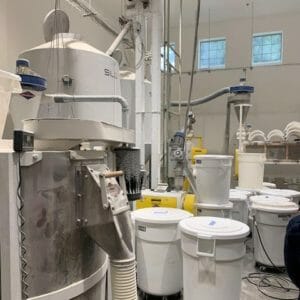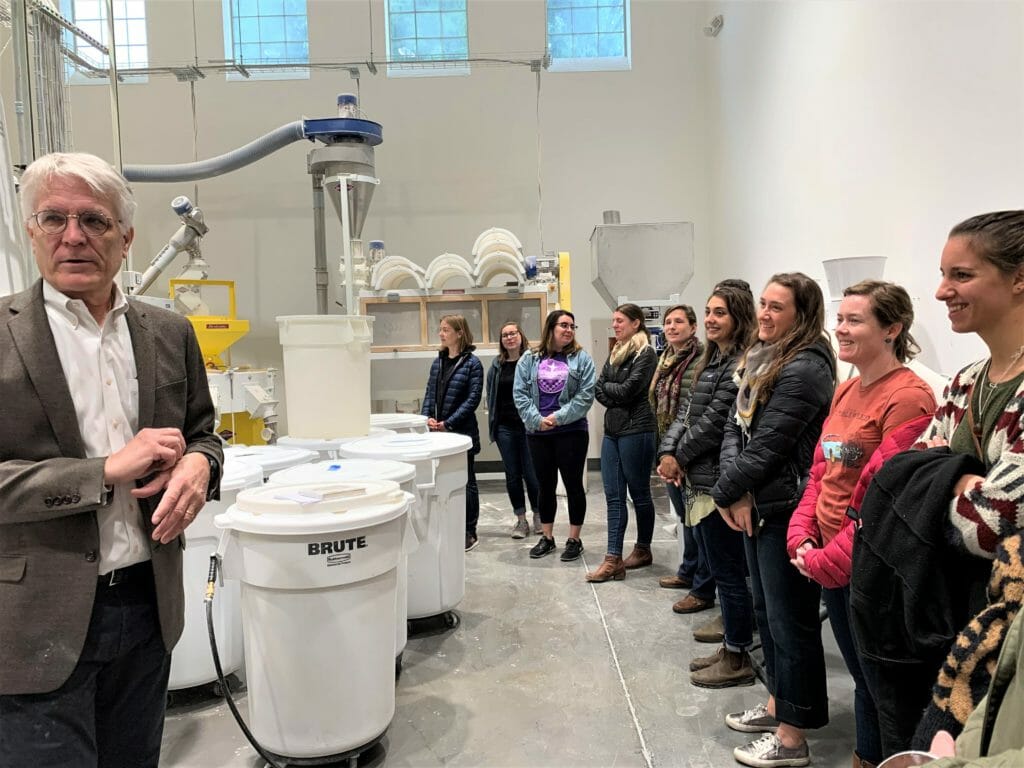This blog post was written by Arizona State University graduate student Ali Kelley. In addition to studying Food Policy and Sustainability Leadership at ASU, Ali is working hard to foster a regional grain economy by starting a grain business of her own in her home state of Colorado.
Arizona is not known for bagels, but one of the best I’ve had can be found on the plains bordering Phoenix. With a tender dough and glistening, golden crust, this bagel rivaled any I’ve experienced in New York, or elsewhere. Was fresh water from the nearby Salt River responsible for this culinary gem? Hardly. The bagel’s unparalleled taste and texture resulted from the quality and freshness of the wheat flour, grown and milled on site. Whereas commercial All Purpose flour comes from modern wheat varieties (bred for yield and resistance) and is processed months or even years before it reaches the end user, this flour came from heritage varieties (known for flavor and nutrition) and was milled within a week of being consumed.
We don’t often think about where flour comes from, or how it’s made. But, as with orange juice and salsa and countless other “best enjoyed fresh” items, the quality of the ingredients — in this case, grains — and the way they are processed turns out to have a big impact on taste and nutrient density.
Jeff Zimmerman discovered this 10 years ago and has been on a journey to reimagine grains ever since. At the time, Zimmerman was juggling a demanding career as a tech consultant with a busy home life, as the father of five. Cooking, and especially baking, were his outlets. A visit to his family’s farm in North Dakota served as a sad reminder of the new realities of farming in America — gone was the era of family farms and community-based agriculture – and inspired him to start searching for sources of better grains, like those he’d grown up with in the Northern Plains.
Determined to break the commodity mold, Zimmerman began networking and attending grain events to learn from people in the community. He soon came across Chris Bianco, Phoenix’s legendary pizzaiolo and James Beard Award winning chef. Bianco had long been convinced of the benefits of heritage grains and was eager to incorporate more into his menu. At the time he met Zimmerman, Bianco was actively searching for his own stone mill and buying grain from Glenn Roberts, whose South Carolina-based Anson Mills was (and remains) the indisputable leader in the wholesale specialty grain market. It wasn’t long before Zimmerman and Bianco formed an alliance and earned the support of Roberts, who was eager to encourage the development of more regional grain economies and donated seed for their first crop.
By 2012, Zimmerman had a product to sell and began courting chefs, bakers and farmers market patrons with bags of freshly milled flour. The early days were by all accounts slow. Zimmerman’s flour was priced at a significant premium to commercial flour and customers were largely unaware of its benefits. To make this work, Zimmerman would need to enlist advocates like Bianco to demonstrate why his flour was better and worth more than the alternative. He made a smart branding decision by acquiring the naming rights to Hayden Flour Mills — a local business established in nearby Tempe in 1874. The mill closed in the late 1990s, a byproduct of industry consolidation and commodification, and left behind a proud legacy.
Carrying the familiar hometown name, Zimmerman found that locals were enthusiastic to connect with him and invested in his success.

Succeed, he did! Fast forward to 2019, Zimmerman and his team of four — led by daughter Emma and general manager Debbie La Bell — are milling hundreds of thousands of pounds of heritage flour annually. About half of this grain goes to regional chefs and bakers, with the remainder sold in retail outlets including Whole Foods. The mill also operates an online direct-to-consumer business, which Hayden is hoping to expand in coming years.
Critical to Hayden’s growth has been a symbiotic relationship with Sossaman Family Farms, which grows much of the company’s grain and hosts the mill and headquarters. Farmer Steve Sossaman, whose family has owned the land in Queen Creek for more than 100 years, was an early champion of the mill and has since co-invested with Zimmerman in the substantial infrastructure necessary to scale the business. Chief among these investments is a Partisani stone mill from Italy, which is both elegant in its simplicity and intimidating in its massive, spider-like footprint.
The farm itself provides a scenic backdrop for community dinner events, which aim to engage area residents around the benefits of better grains through delicious local food and enriching discussion. In addition, the Hayden team hosts weekly workshops to educate consumers on growing, milling and preparing heritage grains. By exposing eaters to the vivid flavors of freshly milled, heritage grains, Jeff and his team are changing the conversation around grains.
If the bagel is any indication, this is a movement that many people will want to join.
On behalf of the entire ASU Food Policy and Sustainability Cohort, I would like to extend our sincere appreciation to Jeff Zimmerman and the whole Hayden Mills team for giving us the opportunity to visit and learn more about their operation and treating us to some delicious bagels.
This piece was informed by a visit to Hayden and subsequent conversation with staff, in addition to an article from AZCentral.com, “Hayden Flour Mills grows tradition and heritage grains” (published online 8/22/14, originally published July 2012).
Interested in learning more about the Food Policy and Sustainability Leadership Program at ASU? Check out its program page!

